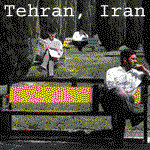Iraq's Babylon bears scars of US-led invasion
 An Iraqi man points to a map showing what ancient Babylon must have looked liked at the entrance of the site in southern Iraq on 6 May.
An Iraqi man points to a map showing what ancient Babylon must have looked liked at the entrance of the site in southern Iraq on 6 May. by Hassan Jouini
The last outsiders to visit the ruins of the once-mighty city of Babylon in Iraq came in tanks and helicopters, leaving a blight on its historic and fragile landscape, archaeologists say.
The city, born on the banks of the Euphrates River 5,000 years ago and full of priceless archaeological treasures, was transformed into a US military camp after the 2003 invasion with a heliport built among the ruins.
The base was later passed to Polish army control and despite the soldiers' departure in 2005, the damage left behind is evident. At a meeting in Berlin next month, Iraqi and other specialists will endeavour to assess the true level of damage.
Iraqi archaeologist Hadi Mussa Qataa, who guided an AFP reporter through the fragile ruins, said helicopter take-offs and landings, along with the tremors from the heavy rumble of armoured vehicles had damaged the city's historic monuments.
Babylon is located in the famed Fertile Crescent between the Euphrates and its sister river, the Tigris, some 85 kilometres (55 miles) southeast of the Iraqi capital Baghdad.
When US-led troops invaded Iraq to topple Saddam Hussein, all that was visible of the ancient city was a collection of mud-brick buildings and debris together with new restoration projects commissioned by the Iraqi strongman.
Saddam was keen to stamp his mark on the site, also home to the Hanging Gardens, one of the Seven Wonders of the Ancient World, and commissioned a huge range of restoration projects starting in the 1980s.
Thousands of Sudanese workers were brought to the site to build monuments on top of the priceless ruins.
"Restoration of the palace of King Nebuchadnezzar under the glorious reign of Saddam Hussein," the tributes read.
Damage done to archaeological artefacts during the restoration work was made worse when US forces set up the 150-hectare (370-acre) base at the site in April 2003, the same month Saddam was overthrown.
Military digging involving soil containing materials of archaeological significance, the construction of the heliport and the seepage of fuel into the soil, all sparked concerns over the condition of the site.
The US military do not deny that damage occurred at some archaeological sites between 2003-2004 but since then, troops have "moved facilities away from many other important archaeological sites," a military spokesman told AFP by email.
A report by the United Nations Educational, Scientific and Cultural Organisation (UNESCO) branded described he damage caused during the military occupation of the site as "very serious."
Already the famous blue bricks that form the lions, bulls and dragons making up the decorations around the Gate of Ishtar, the Babylonian goddess of love, have been found to have been damaged.
The original gate, on display at the Pergamon Museum in Berlin, marked the entrance to the palace, temples and domestic dwellings of the city. These buildings were fashioned out of mud bricks which still bear Babylonian and Assyrian markings.
At least 32,000 items were pillaged from the 12,000 archaeological locations across Iraq during widespread looting which following the invasion. The US military denies involvement in any of the thefts of historical artefacts.
After the Poles left the camp, Babylon was handed over to the Iraqi Antiquities Authority but excavation work and restoration projects have both ground to a halt.
Today, a dirt track, several coils of barbed wire and a few sandbags are the only evidence to show that the ruins were used as a military base.
Leading archaeologists fearing for the physical safety of Babylon's remaining archaeological treasures, have launched efforts to protect the site from further damage and resume archaeological research.
They are pushing for Babylon to be included on a list of protected World Heritage sites. This would mean excavations could be relaunched and archaeologists from around the world would once more have a chance to probe Babylon's rich history.
"The Iraqi authorities must complete an enormous amount of work to achieve this objective and we must prepare a plan to accomplish it," Qataa said.
UNESCO representative in Iraq Mohamed Djelid, who is based in Amman, recognises that for the moment, Iraq is far from ready.
Recommendations made at a special meeting in November 2007 in Paris to discuss the situation in Iraq have still to be implemented, he said.
These include urging the Iraqi authorities to ratify a series of protocols on protection of archaeological sites and the battle against the illegal smuggling of art works.
Labels: Archaeology, History, Iraq, Occupation, United Nations, United States















0 Comments:
Post a Comment
<< Home